ISSN ONLINE(2278-8875) PRINT (2320-3765)
ISSN ONLINE(2278-8875) PRINT (2320-3765)
Prof. M.S. Narlawar1 and Dr. S. L. Badjate2
|
| Related article at Pubmed, Scholar Google |
Visit for more related articles at International Journal of Advanced Research in Electrical, Electronics and Instrumentation Engineering
Evolution of elliptical slotted monopole antenna from as simple disc monopole for sensing purpose and then the design of reconfigurable antenna for cognitive radio application with the sensing antenna sharing same partial ground plane is proposed in this paper. The design consists of two printed monopole antenna printed over FR4 substrate, sharing a common partial ground. The first antenna is the sensing antenna for spectrum sensing, having wideband characteristic and omnidirectional radiation pattern. The second one is the communicating antenna which is a frequency reconfigurable monopole antenna with the switch on the antenna structure. The simulation result shows that the sensing antenna works in the range of 2.23 to12.75 GHz and fabricated counterpart of sensing antenna shows measured results in close conformity with one another while reconfigurable communicating antenna shows reconfiguration in frequency with variation in switch positions.
Keywords |
| cognitive radio, ultra wideband, sensing antenna, reconfigurable antenna, communicating antenna |
INTRODUCTION |
| In recent times, there has been an explosive growth in wireless communications. Also, it is expected that data traffic will double every year which will eventually result in the saturation of the dedicated spectrum. Currently, most spectrum bands have been allocated to licensed users. However, a lot of licensed bands such as those for TV broadcasting are underutilized resulting in spectrum wastage. As a result, the Federal Communications Commission (FCC) has been prompted to open licensed spectrum bands to unlicensed users through the use of Cognitive Radio (CR) technology. With the advent of 3G and 4G mobile communications, CR schemes have begun to receive a lot of attention [1].Presently various research communities have different definitions of CR and its unique defining features. Some view it as primarily about dynamic spectrum sharing while some consider it as a device capable of Cross-layer optimization. The possibilities for antenna to play an active role in system level performance are lost amid all these conceptions of CR. However, an antenna is the most important section of a CR system. Designing an antenna which carries out spectrum sensing as well as transmission is extremely difficult. |
| Some research has been done related to the design of antennas for cognitive radio systems. In [2], the sensing and communicating antennas in the same volume is presented. The sensing antenna is a printed hour glass shaped coplanar waveguide (CPW) fed monopole which is operating at 3.9 GHz to 11 GHz, accomplishing the UWB characteristic. The communicating antenna is printed on the reverse side of the substrate which is designed to operate from 5.15 GHz to 5.35GHz. In [3], the sensing antenna also has the UWB characteristic with slotted polygon – shaped patch with partial ground on the reverse side of the patch. While the frequency reconfiguration is achieved by rotational movement of the triangular – shaped patch communicating antenna. A dual port antenna design for cognitive radio system also presented in [4], where the sensing and communicating antenna proposed have different structure and are positioned apart. The sensing antenna has the egg – shaped radiating patch with tapered microstrip line fed which operates at UWB range. The frequency reconfiguration of communicating antenna is achieved by the switches placed on the antenna structure resulting various resonance frequencies at range 4 GHz to 9 GHz. In [5], a frequency reconfigurable antenna to cover either the 3−5 GHz or the 5−8 GHz bands is designed. |
| This paper presents the evolution of novel ultra wideband slotted elliptical monopole antenna for sensing purpose used for cognitive radio applications. The steps involved in the process of evolution have been detailed along with the comparison of their features. Also a sensing antenna is fabricated and the comparison of simulated results with the measured results of prototype antenna is given. The sensing antenna is further modified by the addition of one more monopole with switches for frequency reconfiguration sharing the same partial ground plane lying side by side as shown. This complete structure behaves as an antenna for cognitive radio. |
PROPOSED ANTENNA DESIGN |
| The proposed UWB monopole antenna is shown in Fig. 1. The printed circular disc monopole antenna with radius r and microstrip feed line are printed on the same side of FR 4 substrate .A circular disc with a radius of 12 mm, a 50 Ω microstrip feed line are printed on one side of the dielectric substrate. In this study, the FR4 substrate used has a thickness of 1.6 mm and dielectric constant of 4.4. The length and the width of the dielectric substrate are 60x50 mm. |
| The width of the microstrip feed line is fixed at 2.6mm to achieve 50Ω impedance. So as to improve the performance of above antenna, slots in the above structure are incorporated. Fig.2 shows the simple disc monopole with three slots. The slots inserted are of same size. The partial ground plane is used in the design. The dimensions of the patch as well as ground plane are given in Table1. |
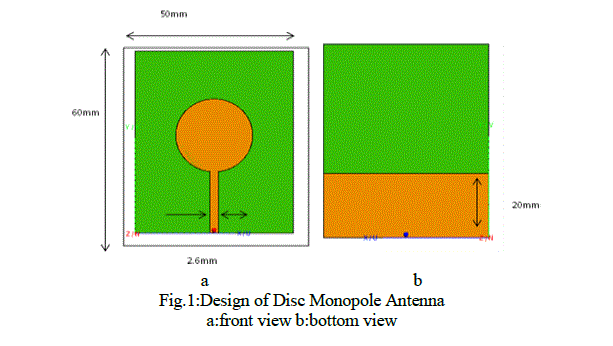 |
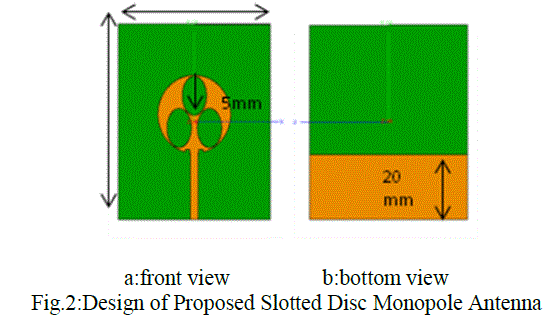 |
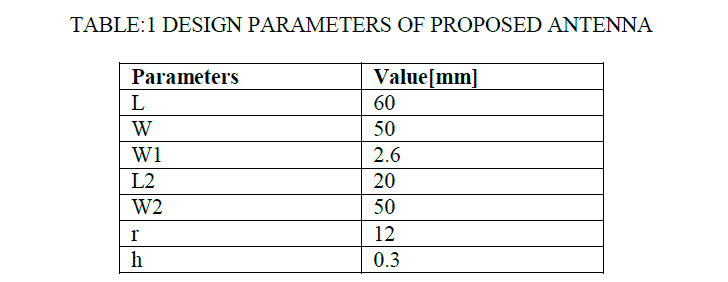 |
| The re-configurable antenna is a simple monopole structure as shown in figure 3 with two switches and sharing the same partial ground plane with the sensing antenna.The two switches on the second monopole antenna in different positions makes it operate in different freuency ranges which makes the design frequency reconfigurable. |
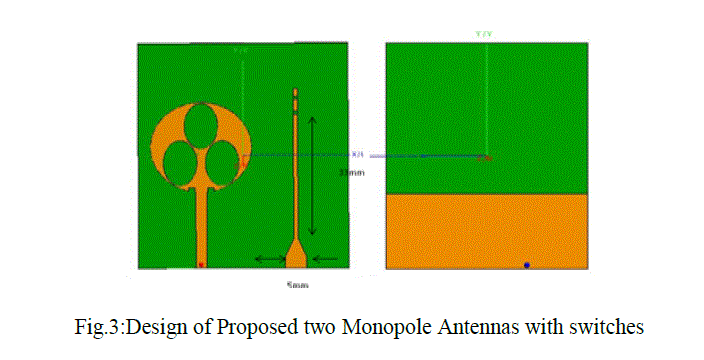 |
| Figure 4 shows the prototype of slotted disc shaped monopole antenna used for sensing purpose. |
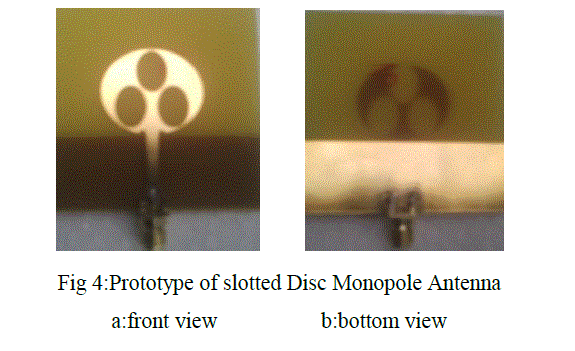 |
SIMULATION |
| The proposed antenna has been simulated in CADFEKO software. The simulated antenna parameters viz. Input impedance, return loss and radiation pattern are shown. Fig.5 and Fig.6 shows the return loss plot for the disc monopole and slotted disc monopole antenna respectively. Fig.7 & Fig.8 shows the impedance plot of disc monopole and slotted disc monopole antenna respectively. Fig.9 shows the radiation pattern of slotted disc monopole antenna. The performance parameters of slotted disc monopole antenna are measured by using the Agilent Vector Network Analyzer and fig.10 shows the comparison of measured and simulated return loss plot of slotted disc monopole antenna. |
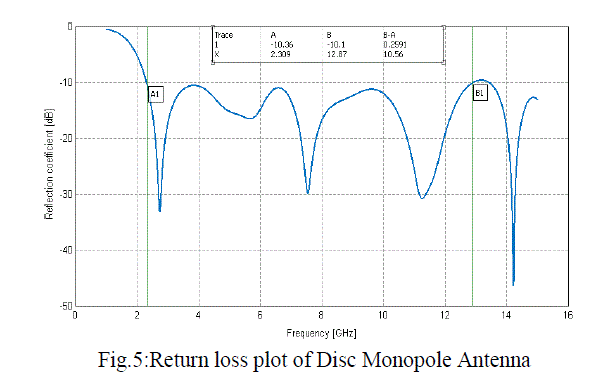 |
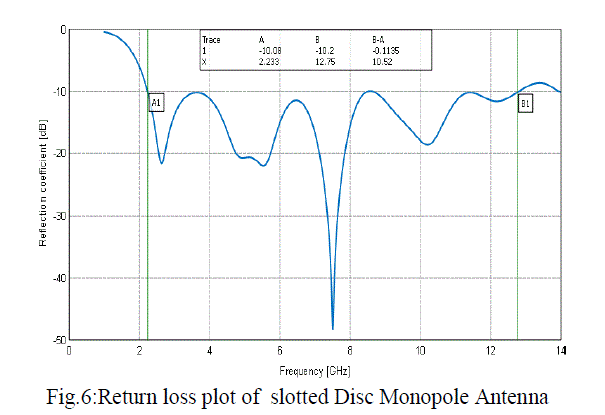 |
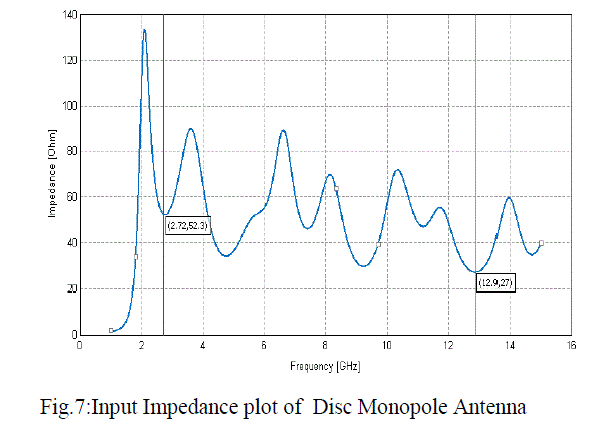 |
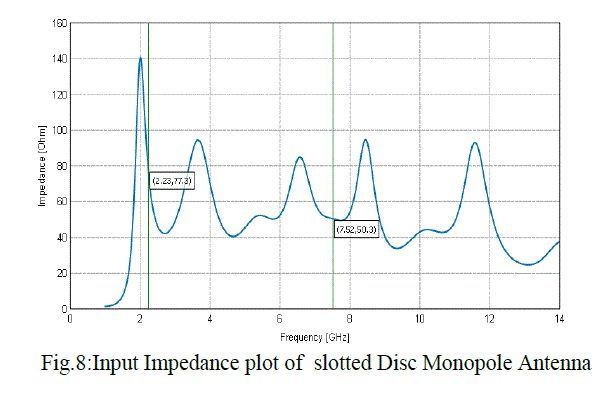 |
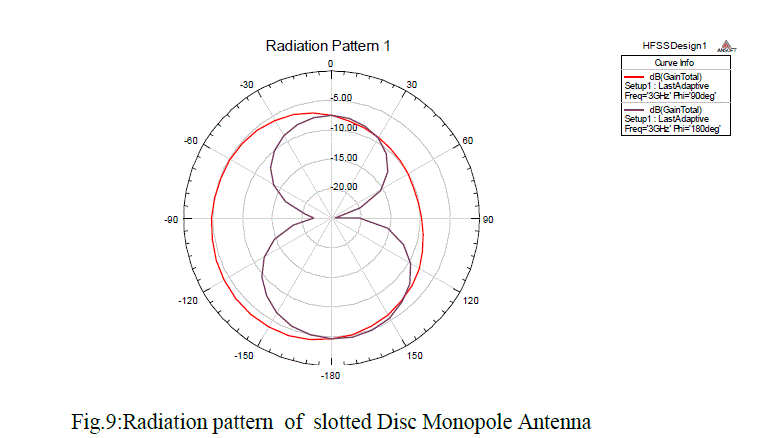 |
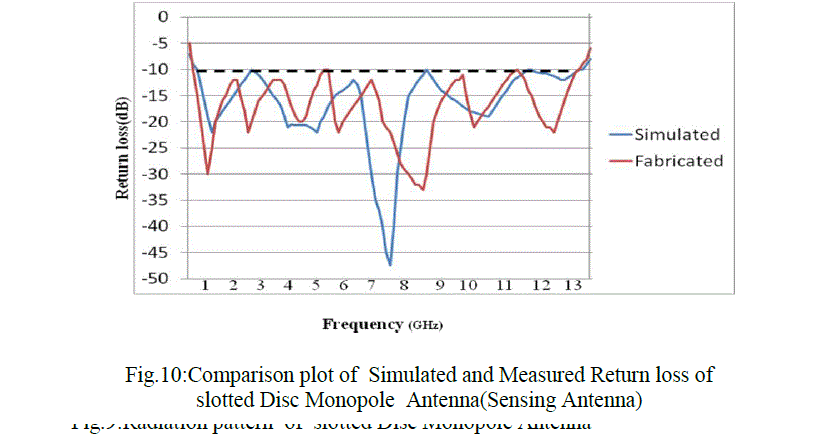 |
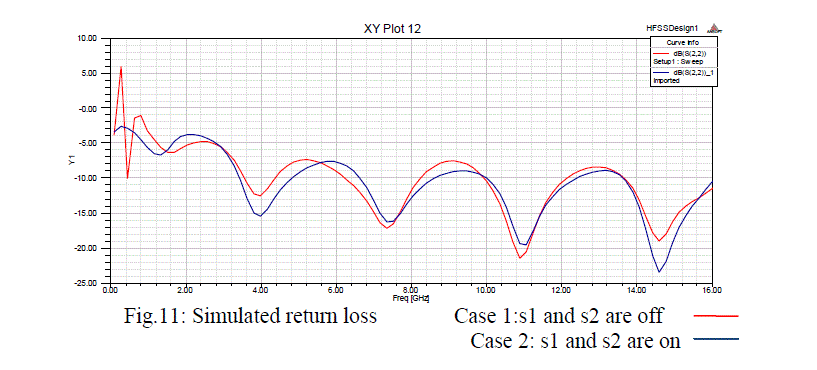 |
RESULTS AND DISCUSSION |
| The proposed antenna has been simulated in CADFEKO software. There is no significant change in band width, but the gain has been increased substantially which is clear from the table 2. Impedance plot shows that the impedance values are close to 50Ω in the desired range for both the antennas. The results of the disc monopole and the evolved slotted monopole design are also compared in Table2 .From the table it is very clear that as we go on introducing elliptical slots in the disc monopole antenna, the performance of antenna improves in all areas i.e. it’s impedance bandwidth increases, gain increases. The return loss plot of the simple monopole antenna shows a wide bandwidth which ranges from 2.309GHz to 12.87GHz.Thus the return loss plot shows an impedance bandwidth of 10.56GHz while it is found to be almost same in case of slotted disc monopole antenna. The impedance bandwidth is calculated by considering the range of frequencies below -10dB. |
| Table 3 shows the comparison of Simulated and fabricated antenna performance parameters whereas Fig.8 shows the comparison of return loss plots of a simulated and fabricated antenna. The simulated and measured parameters of both the antenna are found to be in close conformity with each other. |
| The geometry of slotted disc monopole antenna is further modified by addition of another monopole with switches which acts as a reconfigurable antenna. The reconfigurable antenna with both switches s1 and s2 in off position the response as shown in fig. Similarly by operating the switches in different positions, the responses are studied and their combined response is also shown. It clearly indicates that with change in position [on/off] of switches, the operating range of antenna changes. |
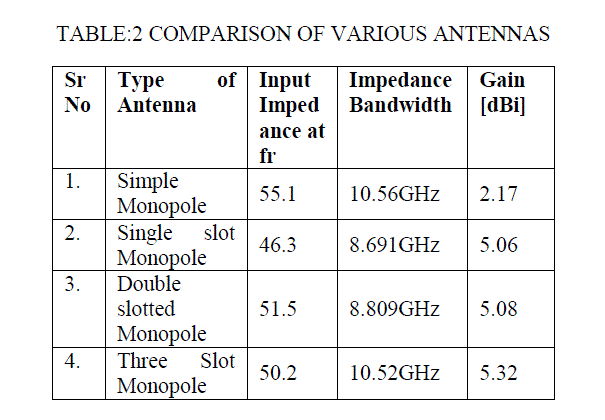 |
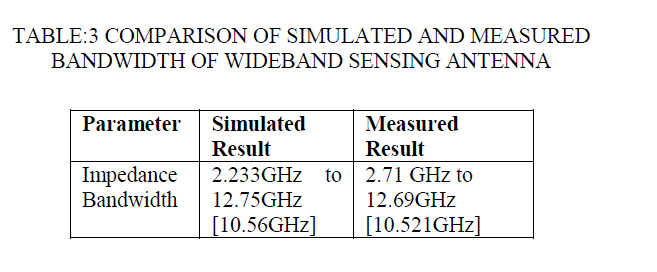 |
CONCLUSION |
| A novel slotted disc monopole antenna has been introduced. By inserting slots one by one into the simple disc monopole, a slotted disc monopole antenna is evolved. It has been observed that as the number of slots in the simple monopole increases, the performance of antenna improves. By combining three techniques: a slotted disc monopole patch, a partial ground plane and a microstrip feed line, the monopole antenna has achieved a measured bandwidth of 10.52GHz for return loss below -10dB and exhibited a nearly omnidirectional radiation pattern .This printed antenna has a simple structure, thin profile, low cost and a very wide impedance bandwidth. Therefore it is an attractive candidate for the sensing operation of Cognitive radio. |
| The sensing antenna is fabricated and measured results of fabricated counterpart are compared with the simulated results which show close conformity with each other. |
| The sensing antenna is further modified by adding a communicating monopole antenna on the same substrate sharing common partial ground plane and separate excitation. The reconfigurable communicating antenna shows frequency reconfiguration with change in switch position s1 and s2.Thus, the two monopole together forms the best candidate as an antenna for cognitive radio applications. |
References |
|